How Improving Your Shoulder and Thoracic Spine Mobility Can Help Your Neck Pain
 Millions of people deal with neck discomfort and pain every day. A lot of the time this can be attributed to poor posture and tight muscles as a result of movements in our everyday lives. But there is good news, assuming there is no structural issue in the spine, the pain in your neck can be alleviated through non-surgical options. Our bodies are made up of a series of alternating mobile and stable joints throughout our body. For example, as we work our way up the body, the ankle is mobile, the knee is stable, the hips are mobile, the lumbar spine should be stable, so on and so forth. When a mobile joint (the thoracic spine and shoulder joint for our purposes) loses its’ mobility, the stable joint (the shoulder blade and lower cervical spine, again for our purposes) above or below it will try to assist to make up for the compensation. So as the thoracic spine or shoulder joint loses its’ mobility, it places more strain on the muscles of the shoulder blades and lower cervical spine because the muscles that are responsible for stabilizing those joints will try to assist in creating mobility. As a result, this can lead to cervical spine issues or cause other muscles in the support the head to be overworked. By performing the following stretches to help mobilize the thoracic spine and shoulder joint, we can take tension out of the muscles that are being overworked that support the head.
Millions of people deal with neck discomfort and pain every day. A lot of the time this can be attributed to poor posture and tight muscles as a result of movements in our everyday lives. But there is good news, assuming there is no structural issue in the spine, the pain in your neck can be alleviated through non-surgical options. Our bodies are made up of a series of alternating mobile and stable joints throughout our body. For example, as we work our way up the body, the ankle is mobile, the knee is stable, the hips are mobile, the lumbar spine should be stable, so on and so forth. When a mobile joint (the thoracic spine and shoulder joint for our purposes) loses its’ mobility, the stable joint (the shoulder blade and lower cervical spine, again for our purposes) above or below it will try to assist to make up for the compensation. So as the thoracic spine or shoulder joint loses its’ mobility, it places more strain on the muscles of the shoulder blades and lower cervical spine because the muscles that are responsible for stabilizing those joints will try to assist in creating mobility. As a result, this can lead to cervical spine issues or cause other muscles in the support the head to be overworked. By performing the following stretches to help mobilize the thoracic spine and shoulder joint, we can take tension out of the muscles that are being overworked that support the head.
Thoracic Extension Stretch using a Foam Roll
- Placing the foam roll just below the shoulder blades
- Make sure that you are supporting your head by placing your hands behind your head, keep your elbows wide to open up the chest.
- Keeping your hips and feet on the floor, slowly extend back over the foam roll to extend the thoracic spine.
- It is important to work through your comfortable range of motion.
- You want to also focus on your breathing when performing this stretch. You want to breathe in as you extend over the foam roll and breathe out when you lift the chest back to neutral spine.
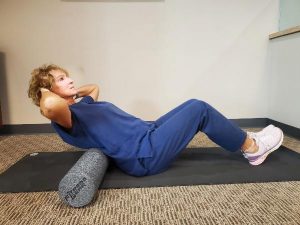
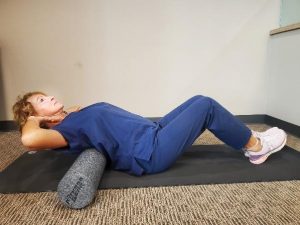
How to Perform the Thoracic Extension Stretch with a Foam Roll
Chest Stretch using the Foam Roll
- Lie on the foam roll so that it goes along your spine, making sure that your head is also supported
- Reach your arms straight up towards the ceiling, take a deep breath in, and then slowly let your arms fall out to the sides, resting your hands on the floor.
- Feel free to place a pillow under the elbow if you feel any elbow discomfort.
- While holding this stretch, focus on your breathing, taking slow, deep breaths to fill your diaphragm to aid in the stretch.
- Breathe in through your nose for 4 seconds, filling your belly and back with air.
- Hold that breath for 7 seconds, and then exhale slowly through the motion for 8 seconds.
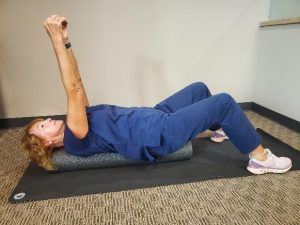
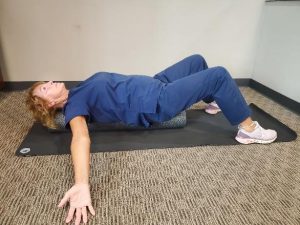
How to Perform the Chest Stretch with a Foam Roll
Rhomboid and Infraspinatus Stretch using a Massage Ball
- Placing the massage ball between your shoulder blade and spine and between your body and the wall, slowly squat down and up to roll the ball along the length of the shoulder blade.
- If you find a spot where you feel a little more pressure or tension, hold on that spot and perform your deep diapragmatic breaths for 4-5 breaths.
- After you have finished your breaths, take the arm on that side and slowly reach down to the floor and up to the ceiling, keeping the arm straight, 5 times.
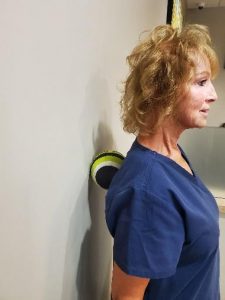
How to Perform the Rhomboid and Infraspinatus Stretch with a Massage Ball
By performing these stretches, you will help mobilize the thoracic spine and shoulder joint, along with stretching any of the tight muscles in the upper back to help take pressure off the muscles in the neck. These are just the first steps to improving or eliminating neck discomfort and pain, but these are the most crucial. From here, we want to start to strengthen the stabilizing muscles for the shoulder blade and lower cervical spine.

